Charles E W Bean, Diaries, AWM38 3DRL 606/270 PART 3/1 - 1918 - 1939 - Part 7
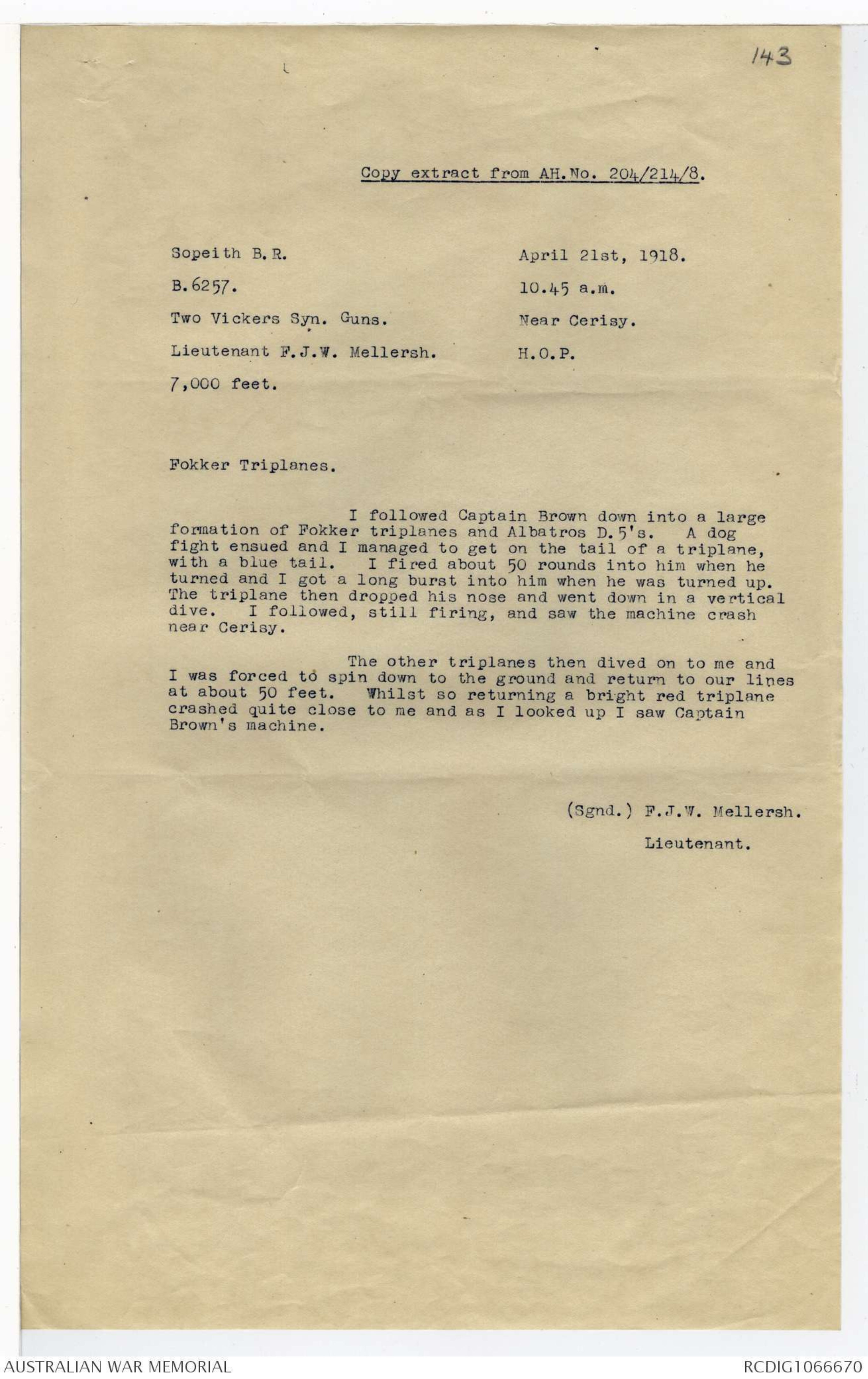
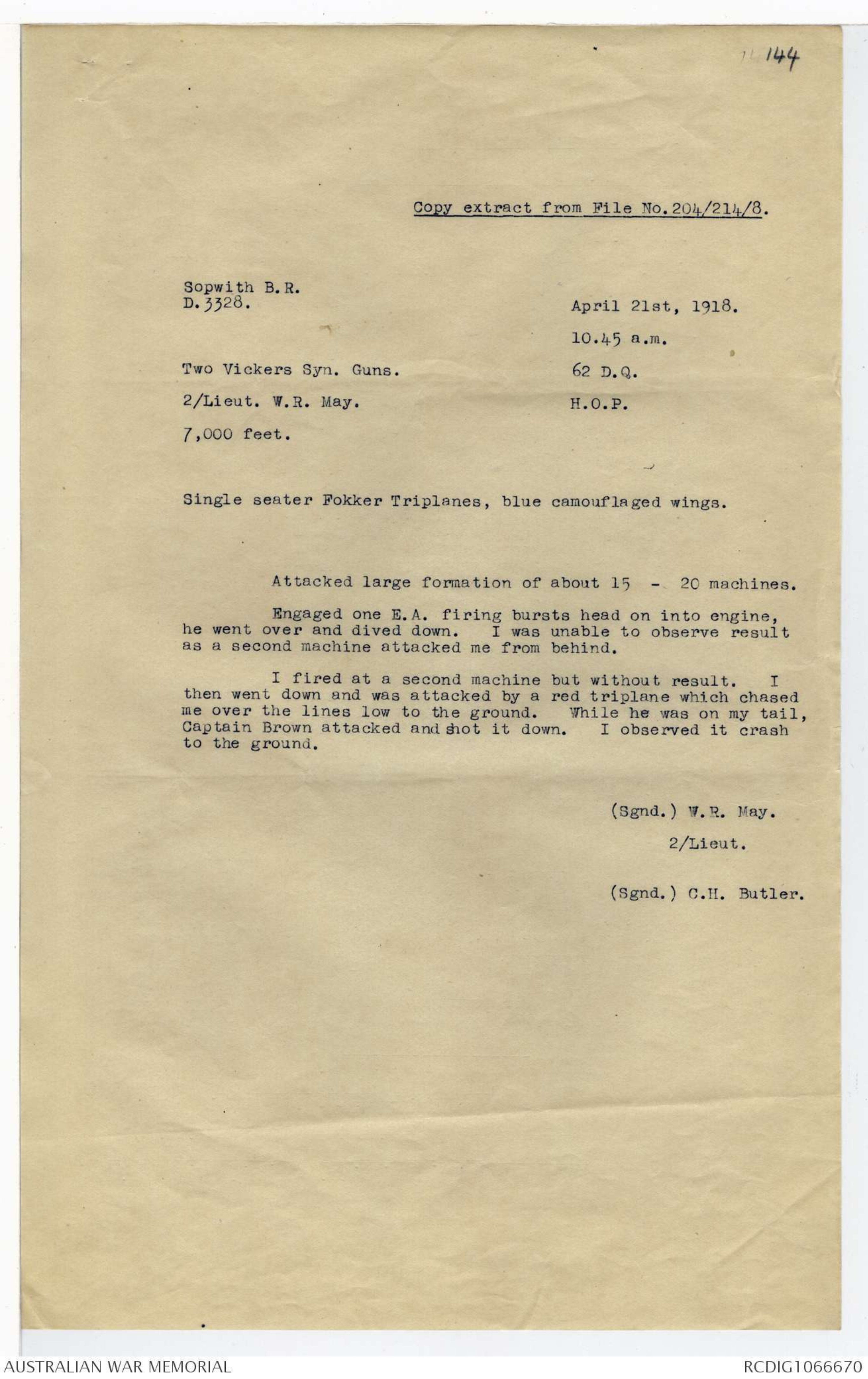


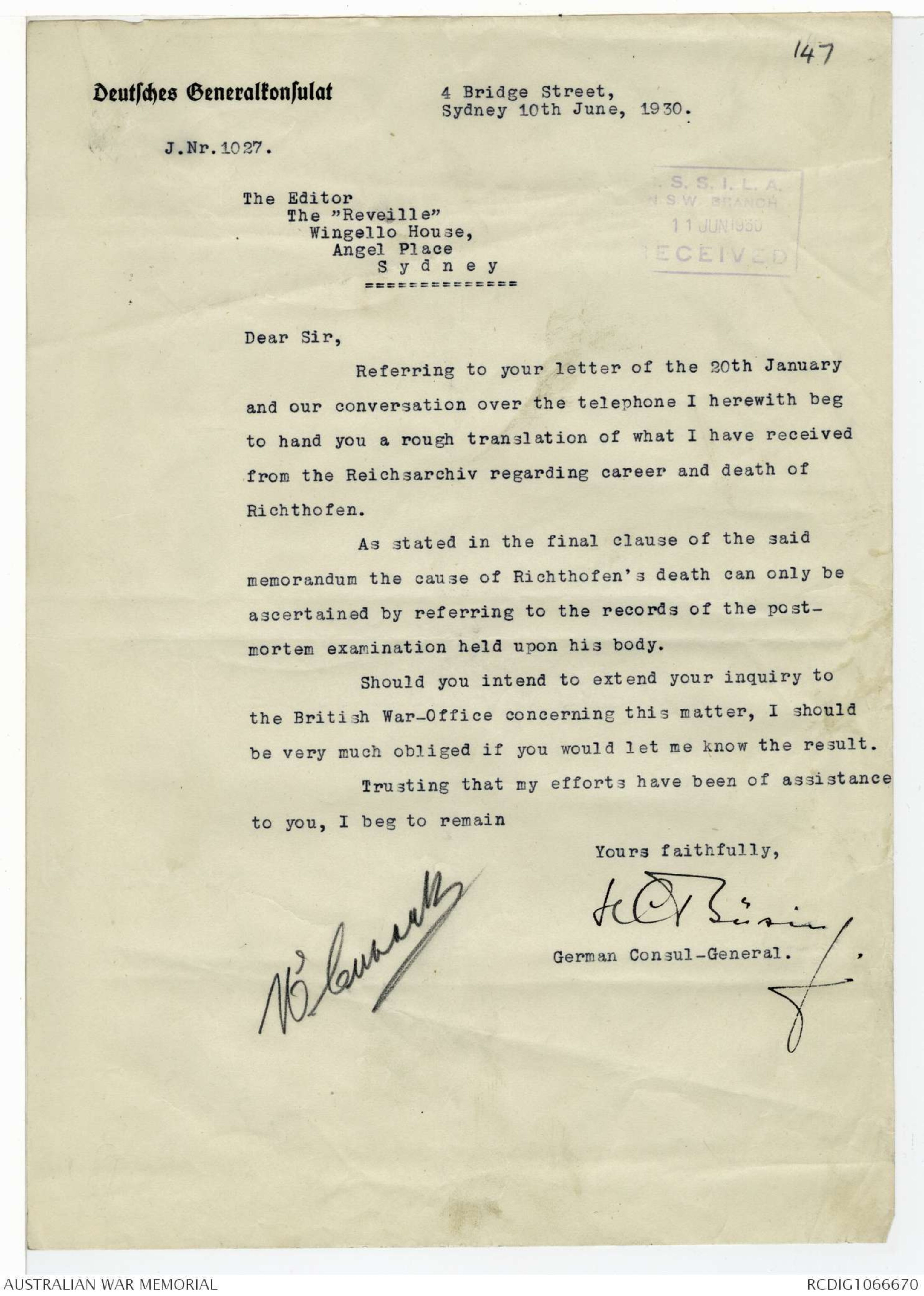


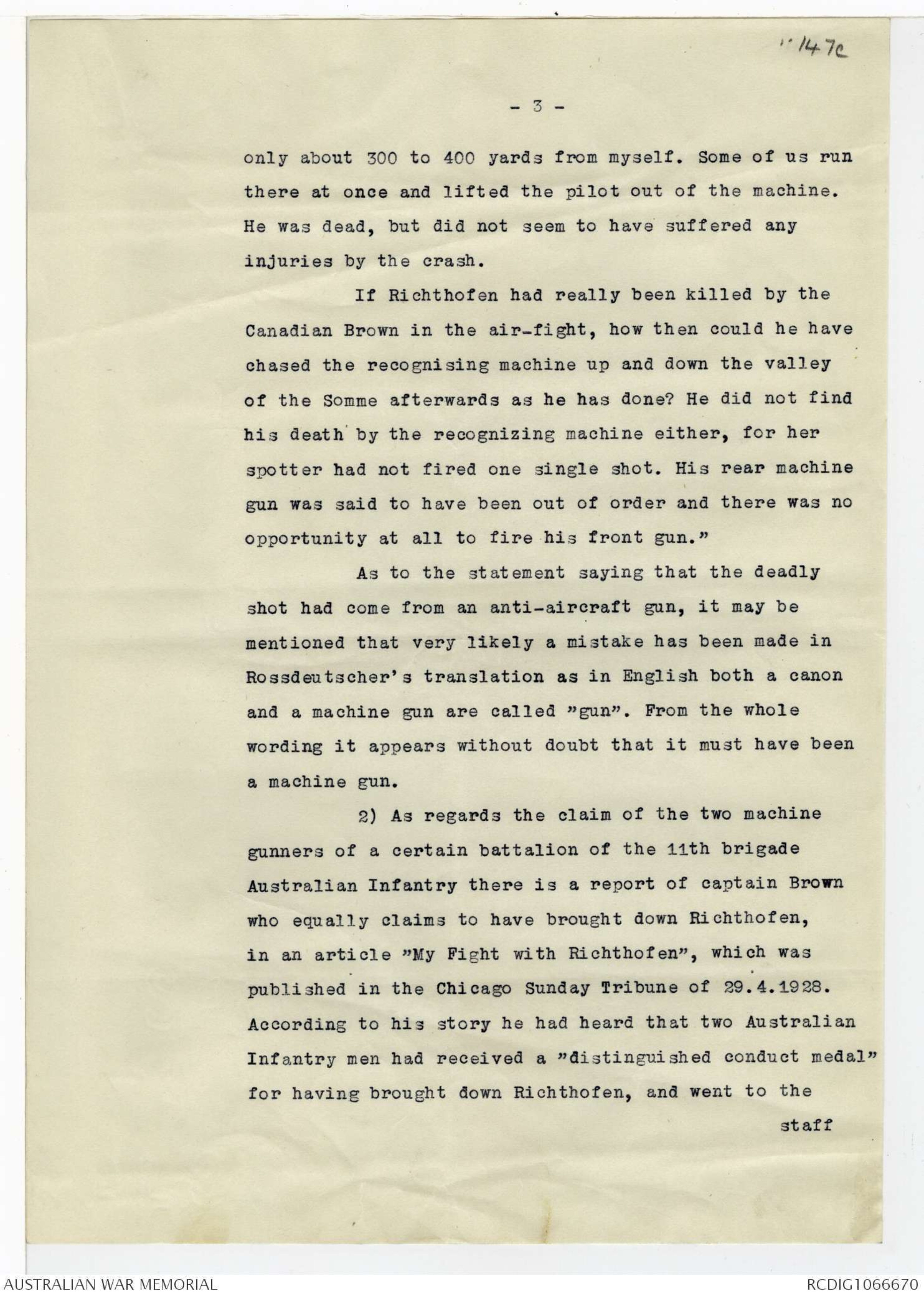

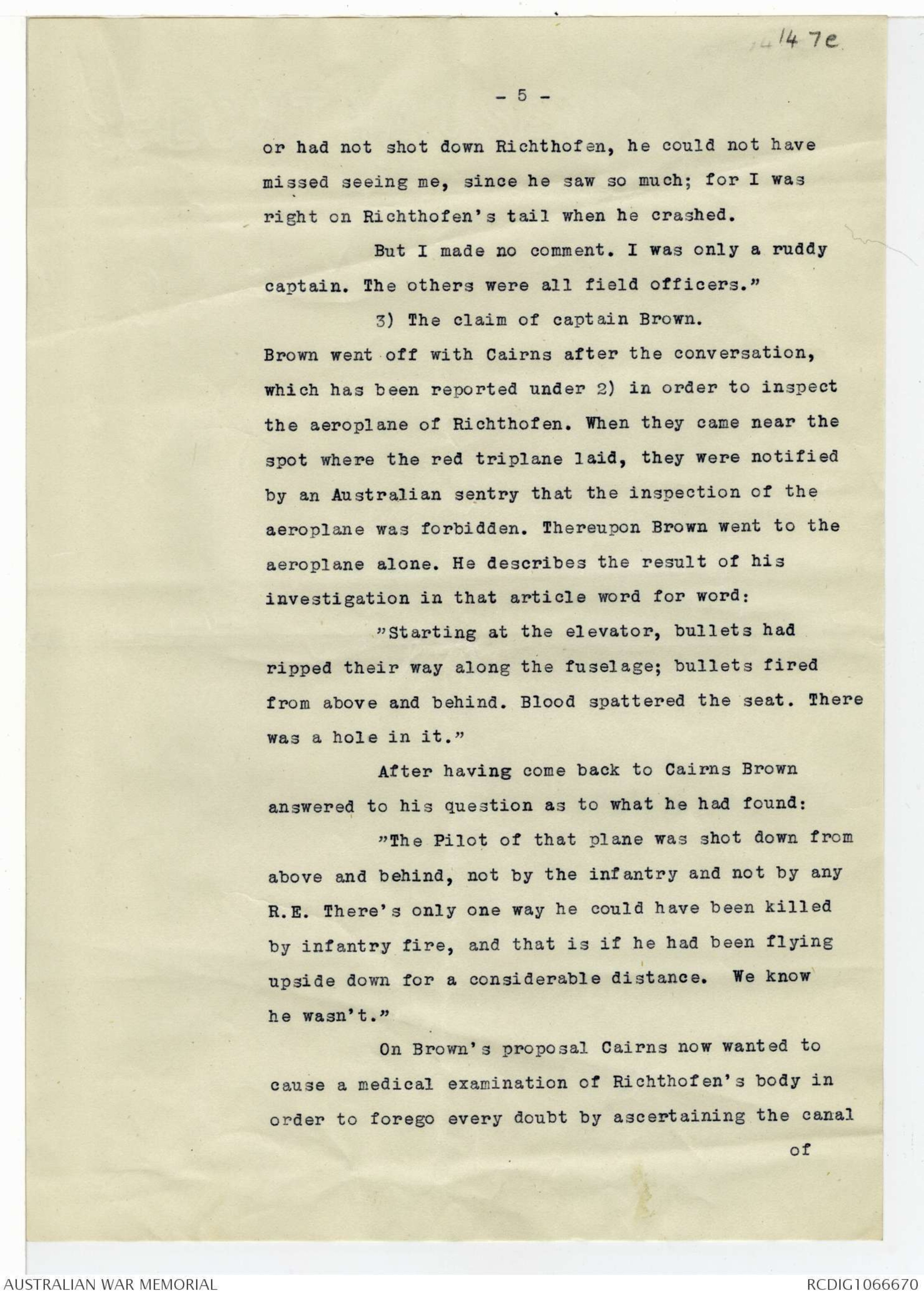
143
Copy extract from AH.No. 204/214/8.
Sopeith B.R. April 21st, 1918.
B.6257. 10.45 a.m.
Two Vickers Syn. Guns. Near Cerisy.
Lieutenant F.J.W. Mellersh. H.O.P.
7,000 feet.
Fokker Triplanes.
I followed Captain Brown down into a large
formation of Fokker triplanes and Albatros D.5's. A dog
fight ensued and I managed to get on the tail of a triplane,
with a blue tail. I fired about 50 rounds into him when he
turned and I got a long burst into him when he was turned up.
The triplane then dropped his nose and went down in a vertical
dive. I followed, still firing, and saw the machine crash
near Cerisy.
The other triplanes then dived on to me and
I was forced to spin down to the ground and return to our lines
at about 50 feet. Whilst so returning a bright red triplane
crashed quite close to me and as I looked up I saw Captain
Brown's machine.
(Sgnd.) F.J.W. Mellersh.
Lieutenant.
144
Copy extract from File No.204/214/8.
Sopwith B.R.
D. 3328. April 21st, 1918.
10.45 a.m.
Two Vickers Syn. Guns. 62 D.Q.
2/Lieut. W.R. May. H.O.P.
7,000 feet.
Single seater Fokker Triplanes, blue camouflaged wings.
Attacked large formation of about 15 - 20 machines.
Engaged one E.A. firing bursts head on into engine,
he went over and dived down. I was unable to observe result
as a second machine attacked me from behind.
I fired at a second machine but without result. I
then went down and was attacked by a red triplane which chased
me over the lines low to the ground. While he was on my tail,
Captain Brown attacked and shot it down. I observed it crash
to the ground.
(Sgnd.) W.R. May.
2/Lieut.
(Sgnd.) C.H. Butler.
145
Copy extract from File No.204/214/8.
Sopwith B.R. April 21st, 1918.
B.3858, B.3338, B. 7200. 10.25 a.m.
Two Vickers Syn. Guns. as stated below.
Captain O.C. le Boutillier H.O.P.
Lieut. Taylor & Foster.
(1). 12,000 ft. (2) 7,000 feet.
(1) I observed 2 Albatros two-seaters over Le Quesnel.
Lieutenants Foster, Taylor and myself fired on one when he
burst into flames and crashed at Beaucourt.
(2) Engaged Fokker triplanes over Cerisy (about 15 - 20
machines) and fired about 100 rounds at a mottled coloured
one but did not get him. Also fired on red triplane which
was shot down by Captain Brown and crashed over side of
lines.
(3) After coming out of the engagement with the Fokker
triplanes Lieutenants Taylor and Foster dived on three
two-seaters close to Albert. Both got in good bursts and
E.A. dived away east. Owing to the fact that 5 E.A. scouts
appeared above and that our ammunition was all used up, we
had to break off the combat without decisive result.
(Sgd.) O.C. le Boutillier,
Captain.
(Sgd.) C. H. Butler.
146
Copy extract from AH. No. 21/k3/1885.
Extract from War Diary of 14th Australian F.A. Brigade
for April.
21/4/18. . . . . "Aircraft very active. An enemy plane
was brought down by Lewis gunners of
53rd Battery, the pilot who was killed
proved to be Capt. Baron von Richthofen."
Extract from War Diary of Headquarters, 5th Australian
Divisional Artillery for April, 1918.
21/4/18. . . . . "The 53rd Battery, 5th Australian
Divisional Artillery, brought down German
Airman Captain von Richthofen."
147
Deutfches Generalfonfulat
4 Bridge Street,
Sydney 10th June, 1930.
J.Nr.1027.
The Editor
The "Reveille"
Wingello House,
Angel Place
Sydney
[*R.S.S.I.L.A.
NSW BRANCH
11 JUNE 1930
RECEIVED.*]
Dear Sir,
Referring to your letter of the 20th January
and our conversation over the telephone I herewith beg
to hand you a rough translation of what I have received
from the Reichsarchiv regarding career and death of
Richthofen.
As stated in the final clause of the said
memorandum the cause of Richthofen's death can only be
ascertained by referring to the records of the post-mortem
examination held upon his body.
Should you intend to extend your inquiry to
the British War-Office concerning this matter, I should
be very much obliged if you would let me know the result.
Trusting that my efforts have been of assistance
to you, I beg to remain
Yours faithfully,
H C Busing
German Consul-General.
[*Mr Cussaks*]
147a
Manfred Freiherr von Richthofen was born in
Breslau, on the 2nd of May, 1892. His father was then
Premier Lieutenant with the Regiment of Leibkürassiere.
Richthofen was instructed by private tutor up to his
ninth year of age, then went to school at Schweidnitz.
Follow eight years in the Corps of cadettes. November
1912 he became Lieutenant at the regiment of Ulanen
Nr.1.
After the outbreak of the war he served in
the cavallery, first against Russia, later on the
western front. In May 1915 he changed over to the
Air-Force and accompanied the advance of Mackensen in
Russia as observer. From February 1916 he was a pilot
himself and joined Kampfstaffel 8 of Kampfgeschwader 2.
On the 24th of August 1916 he was transferred to the
newly formed Jagdstaffel 2 where he obtained his first
successes under the instruction of the famous Boelcke.
After his 16th victory in the air he was made leader
of Jagdstaffel 11 and was distinguished by the order
"Pour le mérite". On the 22nd of March 1917 he was
promoted Premier Lieutenant and on the 8th of April
1917 already became Rittmeister (captain) by preference.
On the 30th of June 1917 he took over command of Jagdgeschwader
1 which according to his advice had been
formed out of Jagdstaffeln 4,6,10 and 11.
Richthofen has brought down 80 enemy machines,
before he was killed himself on the 21st of April 1918.
In
147b
-2-
In appreciation of his outstanding personal performances
and his supreme services rendered to hunting aviation
from May 1918 Jagdgeschwader 1 was called Jagdgeschwader
Freiherr von Richthofen Nr.1.
Four different parties claim to have brought
down Richthofen: The Australian machine gunner W.I. Evans,
53rd battery, 14th brigade of Australian Field-artillery,
two machine gunners of a battalion 11th brigade Australian
Infantry, the Canadian captain Brown of the British
209th (Camel-) squadron and one of the crew in the aeroplane
of an Australian R.E.8-Squadron, which was chased
by Richthofen.
1) The claim of the Australian machine gunner,
W.I.Evans, was dealt with in an article of the Schlesische
Zeitung Nr. 422 of 19.8.1928. The author, M.Rossdeutscher,
Berlin, reproduces there in German translation
a "Report of an eye witness" which was sent him from
Western Australia. According to that report a German
triplane of shining red colour has followed a British
recognising machine and has pressed her down almost to
the top of the trees. Then it goes on verbally:
"Already ^everything seemed to be finished for the
recognising machine which did not fire one single shot,
when suddenly in my closest neighborhood a shot was
fired from an anti-aircraft gun, after which the triplane
at once began to stagger and one moment later fell to
the ground not far from the main road to Corbie and
only
147c
-3-
only about 300 to 400 yards from myself. Some of us run
there at once and lifted the pilot out of the machine.
He was dead, but did not seem to have suffered any
injuries by the crash.
If Richthofen had really been killed by the
Canadian Brown in the air-fight, how then could he have
chased the recognising machine up and down the valley
of the Somme afterwards as he has done? He did not find
his death by the recognizing machine either, for her
spotter had not fired one single shot. His rear machine
gun was said to have been out of order and there was no
opportunity at all to fire his front gun."
As to the statement saying that the deadly
shot had come from an anti-aircraft gun, it may be
mentioned that very likely a mistake has been made in
Rossdeutscher's translation as in English both a canon
and a machine gun are called "gun". From the whole
wording it appears without doubt that it must have been
a machine gun.
2) As regards the claim of the two machine
gunners of a certain battalion of the 11th brigade
Australian Infantry there is a report of captain Brown
who equally claims to have brought down Richthofen,
in an article "My Fight with Richthofen", which was
published in the Chicago Sunday Tribune of 29.4.1928.
According to his story he had heard that two Australian
Infantry men had received a "distinguished conduct medal"
for having brought down Richthofen, and went to the
staff
147d
-4 -
staff of the 11th Brigade Australian Infantry in company
of his wing commander Cairns in order to clear up the
matter. Brown reports the conversation with the Major
commanding the section in question who had been called,
as follows:
"That Australian major had his story pat.
They had been watching the scrap, he said. They had
witnessed the triplanes' attack on the R.E.8. Then they
had seen the Camel's jump on the tripes and engage them
heavily. After a terrific mixup, a red nosed Camel had
broken loose from the fight and had been immediately
dived on by an all red triplane. The pair of them, one
chasing the other, had come closer, closer, closer;
so close and so low at last that he had ordered his
machine gunners to open fire on the enemy flyer.
They had, he said, barely got their guns
concentrated when they brought him down.
"Were there any other red nosed Camels about?"
asked Cairns.
"No", said the major. "There was just the one
that was being chased. He flew right on." And he did not
bat an eye.
I spoke only once.
"And what", I asked, "did the red nosed Camel
behind the all red tripe do?"
The major hesitated, flushed, stuttered.
"He - he - b-but there was no red nosed Camel
behind!"
I knew then that he lied. For, whether I had
or
147e
-5-
or had not shot down Richthofen, he could not have
missed seeing me, since he saw so much; for I was
right on Richthofen's tail when he crashed.
But I made no comment. I was only a ruddy
captain. The others were all field officers."
3) The claim of captain Brown.
Brown went off with Cairns after the conversation,
which has been reported under 2) in order to inspect
the aeroplane of Richthofen. When they came near the
spot where the red triplane laid, they were notified
by an Australian sentry that the inspection of the
aeroplane was forbidden. Thereupon Brown went to the
aeroplane alone. He describes the result of his
investigation in that article word for word:
"Starting at the elevator, bullets had
ripped their way along the fuselage; bullets fired
from above and behind. Blood spattered the seat. There
was a hole in it."
After having come back to Cairns Brown
answered to his question as to what he had found:
"The Pilot of that plane was shot down from
above and behind, not by the infantry and not by any
R.E. There's only one way he could have been killed
by infantry fire, and that is if he had been flying
upside down for a considerable distance. We know
he wasn't."
On Brown's proposal Cairns now wanted to
cause a medical examination of Richthofen's body in
order to forego every doubt by ascertaining the canal
of
 Sam scott
Sam scottThis transcription item is now locked to you for editing. To release the lock either Save your changes or Cancel.
This lock will be automatically released after 60 minutes of inactivity.